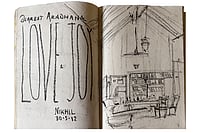In 1993, British artist Rachel Whiteread made an installation titled House in East London that addressed the social erasure of memory. The ghost of a Victorian terraced house that was to be demolished, the installation became controversial and was later demolished. A green corridor was to come up following a cleansing of the area of houses for people dislocated by World War II. We experience dislocation in India all the time. But public art in India is hardly ever political and inclusive of the working class. The House was the statue of an absent house. It changed the general perception about casting, about memory itself. It was an anti-gesture.
By making a concrete cast of the interior of the entire three-story house, Whiteread collapsed its ability to create new memories and preserved the memories buried on the inside. The House was removed by the local council shortly afterwards. But the structure remains entrenched in the memory of those who saw it or read about it. It was an ode to the Victorian ideal of dignified housing. Thereby, it addressed the politics of housing, of power, of money and of society and memory’s insistence to prevail, of subaltern identities.
In the middle of the debate over the politics of statues, and who gets to be cast and who gets defaced and pulled down, what’s absent are such markers of society like the House. We are people who like to commemorate the dead. And any commemoration in a public space is a political act. We have heroes and a few heroines. We build some, we deface others. Let’s say, we even dedicate some to artists. But the working class is missing. Their stories are missing. There are no statues dedicated to him, though one dedicated to R.K. Laxman’s iconic Common Man exists in Mumbai. All meditated absence is political. And all the mythologies and the constructed histories leave unanswered questions regarding what is truly valued in our society. Public art in India rarely addresses such absences or the concerns and representations like the House.
In a country where “development” seems to be the magic word, do we commemorate those left behind? Mayawati’s statues were an attempt to assert an identity that was always repressed. What is art, and what purpose does it serve? Is it ‘art for art’s sake’ and ‘art for life’s sake?’ If building statues is considered public art, do we consider the different gazes? Let’s look at Phoolan Devi’s statues that have been in the news this election season with the Bihar-origin Vikassheel Insaan Party (VIP) foraying into electoral politics of Uttar Pradesh through installation of statues of the late bandit-turn-politician. The political aesthetics of those busts in a sari with folded hands bring to the forefront the question of the male gaze and other pertinent impositions of society.
ALSO READ: Statues And The Construction Of Memory
A couple of years ago, I was in her village, Garha Ka Purwa, in Chambal, where the Eklavya Sena had put up her statue. Carved from marble and moulded by the male gaze, the woman who wandered the ravines of Chambal and killed upper caste men who had once allegedly raped her, the statue itself is emblematic of the political aesthetics of statues in this country. She looked demure in a sari with folded hands. They chose to remember her as a redeemed woman who had attained salvation. Her once matted hair was now painted in black, parted in the middle and tied in a bun. It was far from the image of the woman in fatigues with a gun slung from her shoulders, a red bandana reining in her wild hair. In death, we take liberties. We exploit, too.
These were the trigger points for the issue that looks at the political and cultural history of statues in this country and the various gazes.
(This appeared in the print edition as "What Do We Value? Memory Or History?")

























